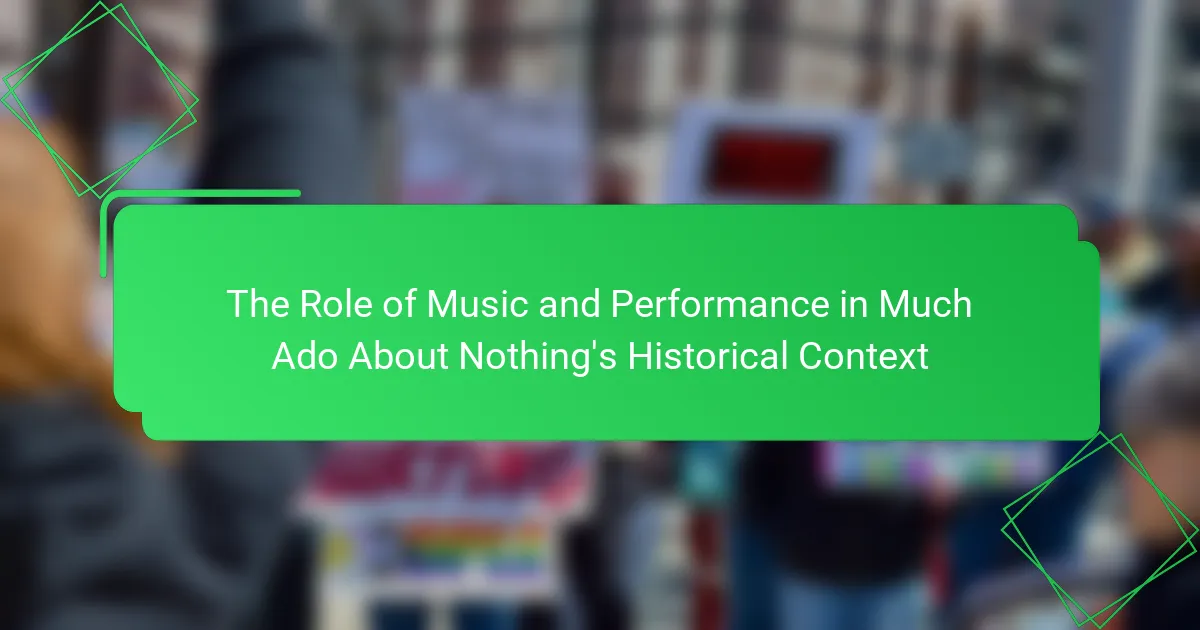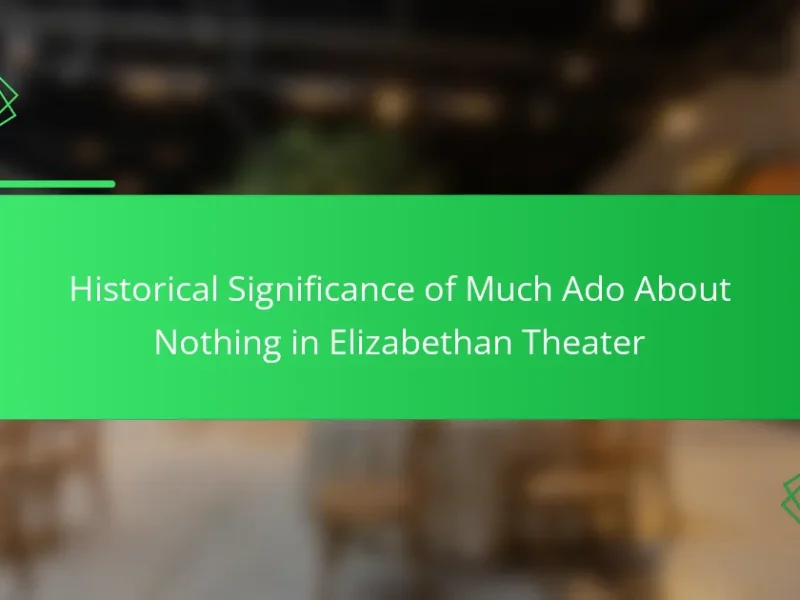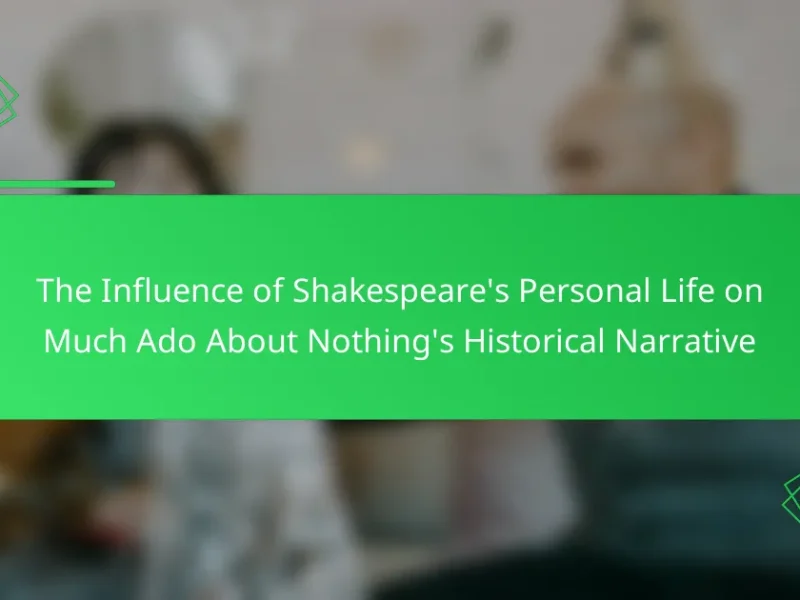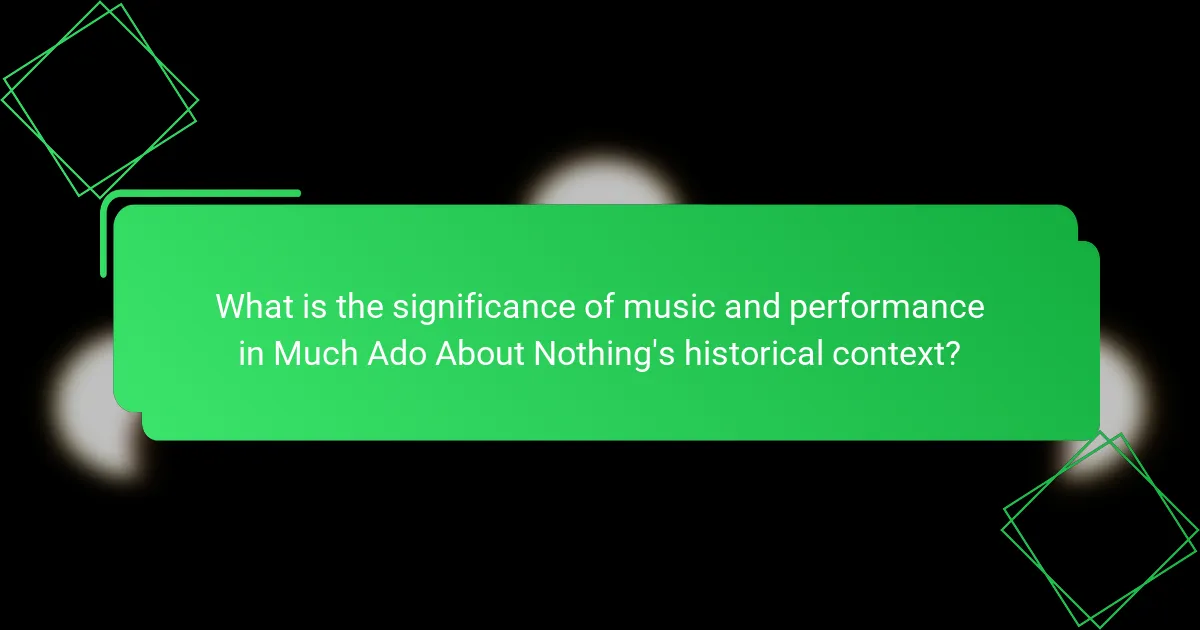
What is the significance of music and performance in Much Ado About Nothing’s historical context?
Music and performance play a crucial role in Much Ado About Nothing’s historical context. They reflect the social customs and entertainment practices of the Elizabethan era. During this time, music was integral to theatrical productions. It enhanced emotional expression and character development. Performances often included songs and dances, engaging the audience. The use of music also signified social status and cultural refinement. Historical records indicate that music was a popular element in Shakespearean plays. This practice contributed to the overall enjoyment and accessibility of the theater for diverse audiences.
How did music influence the storytelling in Much Ado About Nothing?
Music significantly influenced the storytelling in Much Ado About Nothing by enhancing emotional depth and character development. The use of songs and musical interludes provided context to the characters’ emotions. For example, the playful banter between Beatrice and Benedick is often underscored by music, adding a layer of irony and humor. Additionally, music serves as a narrative device that foreshadows events and reveals character intentions. The song “Sigh No More” encapsulates themes of love and betrayal, reinforcing the play’s central conflicts. Shakespeare utilized music to create atmosphere and transition between scenes, maintaining audience engagement. Overall, music in the play is integral to both the plot and the emotional resonance of the characters.
What types of music were prevalent during the time of Shakespeare?
During the time of Shakespeare, various types of music were prevalent. The music included vocal compositions, instrumental pieces, and folk songs. Popular forms were madrigals and ballads. Instruments like lutes, viols, and recorders were commonly used. Courtly music often featured elaborate compositions for performances. Additionally, street music played a role in public entertainment. The Elizabethan era embraced both sacred and secular music. This diversity reflected the cultural richness of the period.
How did the musical elements enhance character development in the play?
Musical elements in the play enhance character development by providing emotional depth and context. Songs and instrumental pieces reflect characters’ inner thoughts and emotions. For instance, the use of music during pivotal moments highlights shifts in relationships. The melodies can signify joy, tension, or sorrow, aligning with character arcs. Additionally, musical interactions often reveal hidden traits or motivations. This layered approach allows the audience to connect more deeply with the characters. Historical context shows that music was integral to storytelling in Shakespeare’s time. Thus, the musical elements serve as a crucial tool for character exploration and audience engagement.
Why is performance important in understanding the historical context of Much Ado About Nothing?
Performance is important in understanding the historical context of Much Ado About Nothing because it reveals the social norms and cultural practices of the Elizabethan era. Theatrical performances during this time were a reflection of societal values, including gender roles and class distinctions. For instance, the use of male actors to portray female characters highlights the constraints on women in the period.
Additionally, the performance style of the time, which included elements like improvisation and audience interaction, provides insight into how audiences engaged with the text. Historical records indicate that Shakespeare’s plays were often performed in public spaces, making them accessible to a diverse audience.
This accessibility influenced the themes and language used in the play, as it needed to resonate with various social classes. Understanding these performance dynamics helps contextualize the play’s humor and commentary on relationships, making it a rich subject for analysis in its historical setting.
What role did live performances play in Elizabethan society?
Live performances were central to Elizabethan society. They served as a primary form of entertainment for diverse audiences. Theaters like The Globe attracted people from various social classes. Performances often conveyed social commentary and reflected contemporary issues. They played a crucial role in shaping public opinion and cultural norms. Many playwrights, including Shakespeare, gained fame through their works performed live. The popularity of these performances fostered a vibrant arts scene in London. Overall, live performances were essential in promoting community engagement and cultural exchange.
How did the nature of theatrical performances influence audience reception?
The nature of theatrical performances significantly influenced audience reception by shaping emotional engagement and cultural context. Live performances created immediate connections between actors and viewers. The use of music heightened emotional responses, making scenes more impactful. Audience reactions were often spontaneous, reflecting their engagement with the performance. Historical context also played a role; performances often mirrored societal norms and issues. This relevance made the content resonate more with audiences. Additionally, the physicality of live acting brought stories to life in a way that written text could not. Consequently, the nature of these performances fostered a dynamic interaction that shaped how audiences perceived and interpreted the narratives presented.
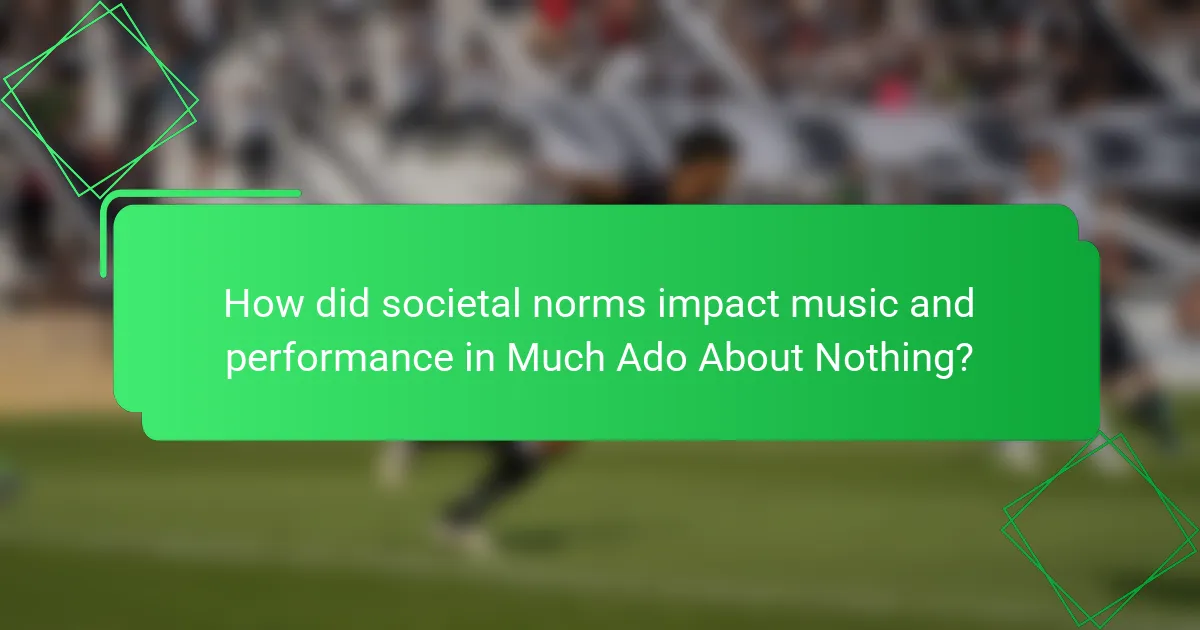
How did societal norms impact music and performance in Much Ado About Nothing?
Societal norms significantly influenced music and performance in Much Ado About Nothing. The play reflects the Elizabethan era’s values, particularly regarding gender roles and social hierarchy. Music served as a tool for social commentary and character development. For instance, songs often highlighted themes of love, honor, and deception, aligning with societal expectations. Performance styles also adhered to norms, with male actors portraying female roles, emphasizing the limitations placed on women. The use of music in courtship scenes illustrated the importance of social rituals. Overall, societal norms shaped both the content and the presentation of music and performance in the play.
What were the expectations of music and performance in Shakespearean theatre?
In Shakespearean theatre, audiences expected music and performance to enhance the emotional and narrative experience. Music served as a tool to convey mood, character emotions, and thematic elements. Performances were characterized by a blend of spoken dialogue and musical interludes. The use of songs and instrumental music was common, often reflecting the play’s context. For example, in “Much Ado About Nothing,” music underscores key moments, enhancing the romantic and comedic elements. Audiences anticipated lively performances, with actors displaying physicality and expressiveness. The integration of music and performance aimed to engage the audience fully, creating a memorable theatrical experience.
How did gender roles affect musical performances in the play?
Gender roles significantly influenced musical performances in the play. In “Much Ado About Nothing,” women often performed in domestic settings, reflecting societal expectations. Their music was typically associated with emotional expression and nurturing qualities. Men, conversely, engaged in public performances that showcased authority and bravado. This division reinforced traditional gender norms of the time. For instance, female characters like Hero and Beatrice used music to convey their feelings and assert their identities. Male characters, such as Benedick and Claudio, displayed their masculinity through musical bravado. These dynamics illustrate how gender roles shaped the context and content of musical performances in the play.
What societal issues were reflected through music in Much Ado About Nothing?
Music in Much Ado About Nothing reflects societal issues such as love, honor, and social status. The songs often highlight romantic relationships and the complexities involved. They also address themes of deception and loyalty among friends and lovers. Additionally, music serves to comment on gender roles and expectations of women in society. For instance, the character of Beatrice challenges traditional notions of femininity through her witty songs. The use of music also underscores the importance of reputation and public perception in the play. These elements collectively illustrate the social dynamics and conflicts of Shakespeare’s time.
How did historical events shape the music and performance styles of the time?
Historical events significantly influenced the music and performance styles of their time. For instance, the Renaissance period saw a revival of interest in classical antiquity, which led to the incorporation of ancient Greek and Roman elements into music and theatrical performances. The Protestant Reformation shifted the focus of music from the [censured] to secular themes, resulting in the rise of folk and popular music. The English Civil War caused a decline in theatrical performances, but the Restoration brought about a resurgence, leading to more elaborate staging and musical compositions. Additionally, the establishment of public theaters in the late 16th century provided a platform for diverse musical styles to flourish. These events collectively shaped the evolution of music and performance, reflecting the cultural and social dynamics of the time.
What historical events influenced the themes in Much Ado About Nothing?
The historical events that influenced the themes in Much Ado About Nothing include the political climate of late 16th-century England and the social dynamics of the Elizabethan era. The play reflects the tensions between social classes and gender roles prevalent during this time. The rise of the middle class and changing views on marriage are evident in the relationships depicted in the play. Additionally, the influence of Italian comedies and humanist ideas shaped its comedic elements and character interactions. The historical context of war and peace, particularly the recent conflicts with Spain, also informs the themes of honor and reputation. These events provide a backdrop that enhances the understanding of the play’s exploration of love, deception, and societal expectations.
How did the political climate of the era affect theatrical productions?
The political climate of the era significantly influenced theatrical productions. Theatrical works often reflected societal tensions and political issues. For instance, during times of political unrest, plays could serve as a means of protest or commentary. The censorship laws in place affected what could be shown on stage. The monarchy’s approval was often required for productions. This led to a focus on themes that aligned with governmental interests. Productions could also be used to promote nationalistic sentiments. Historical events, such as wars or revolutions, were frequently depicted in plays. Overall, the political environment shaped the content and presentation of theatrical works.

What are the lasting impacts of music and performance from Much Ado About Nothing?
The lasting impacts of music and performance from Much Ado About Nothing include its influence on theatrical traditions and cultural expressions. The play integrates music to enhance character development and emotional resonance. Its comedic elements are often accentuated through musical interludes, creating a unique blend of humor and melody. This approach has inspired countless adaptations and performances across various cultures. Notably, the use of music in the play has influenced the incorporation of sound in modern theatrical works. The character of Balthasar, for instance, demonstrates how music can serve as a narrative device. Historical performances often highlighted the role of music in engaging audiences, making the work memorable. Overall, Much Ado About Nothing has left a significant mark on the relationship between music and drama in theatrical history.
How have modern interpretations of the play incorporated music and performance?
Modern interpretations of the play have incorporated music and performance through various innovative approaches. Directors often use music to enhance emotional depth and thematic resonance. Live musical performances may accompany key scenes, creating a dynamic atmosphere. Additionally, modern adaptations frequently include contemporary musical styles to connect with current audiences. The integration of dance and movement has also become prevalent, adding a visual layer to the storytelling. Productions may feature original compositions or popular songs that align with the narrative. This approach not only modernizes the play but also invites audience engagement. Recent productions have showcased these elements, demonstrating their effectiveness in revitalizing the classic text.
What contemporary performances highlight the role of music in the play?
Contemporary performances that highlight the role of music in “Much Ado About Nothing” include various adaptations and productions that integrate live music and original compositions. These performances often use music to enhance emotional depth and character development. For instance, the 2014 film adaptation directed by Joss Whedon features a modern setting with a focus on acoustic music, which underscores the romantic and comedic elements of the play. Additionally, the Royal Shakespeare Company’s productions frequently incorporate live musicians to create an immersive experience. These adaptations demonstrate how music can be a vital storytelling tool in bringing Shakespeare’s work to life.
How do modern audiences perceive the historical context of music in Much Ado About Nothing?
Modern audiences perceive the historical context of music in Much Ado About Nothing as integral to the play’s themes and character interactions. Music serves as a narrative device that enhances emotional depth and social commentary. Audiences recognize that the music reflects the societal norms of the Elizabethan era. It highlights courtship rituals and social hierarchies present in the 16th century. The use of music also provides insight into the cultural significance of entertainment during that time. Scholars note that musical interludes often signify transitions in mood or plot. This understanding enriches the modern viewing experience, allowing audiences to connect with historical perspectives. Overall, the historical context of music is viewed as a vital element in interpreting the play’s meaning.
What practical insights can be drawn from the role of music and performance in Much Ado About Nothing?
Music and performance in Much Ado About Nothing highlight social dynamics and character relationships. They serve as tools for communication and emotional expression. The play features songs that reflect themes of love and deception. For example, the song sung during the wedding scene underscores the tension between the characters. Performance enhances the comedic elements, engaging the audience in the narrative. Additionally, music creates a festive atmosphere, aligning with the play’s themes of celebration and conflict resolution. The integration of music and performance illustrates the cultural significance of entertainment in the Elizabethan era. Overall, these elements reinforce the play’s exploration of human relationships and societal norms.
How can understanding historical context enhance modern theatrical productions?
Understanding historical context enhances modern theatrical productions by providing deeper insights into themes and character motivations. This understanding allows directors and actors to make informed choices that resonate with contemporary audiences. For example, recognizing the societal norms of the Elizabethan era can inform the portrayal of gender roles in “Much Ado About Nothing.” Historical context also helps in interpreting language and humor that may otherwise be lost. Productions can incorporate period-appropriate music and staging, enriching the audience’s experience. Research indicates that audiences engage more when they see relevant historical connections. Therefore, grounding performances in historical context fosters authenticity and relevance.
What best practices can be applied to integrate music in contemporary adaptations of Shakespeare’s works?
Integrating music in contemporary adaptations of Shakespeare’s works can enhance emotional resonance and contextual relevance. Utilize original compositions that reflect the themes of the play. This approach allows for a modern interpretation while staying true to Shakespeare’s intent. Incorporate music at pivotal moments to underscore character emotions and transitions. Historical context can guide the choice of musical styles, aligning them with the era depicted in the play. Collaborate with musicians to create a cohesive sound that complements the narrative. Use music to bridge cultural gaps, making the work accessible to diverse audiences. Consider audience engagement through interactive musical elements, enhancing their experience. Studies show that music can significantly influence audience perception and emotional response, validating its importance in adaptations.
The main entity of the article is “Much Ado About Nothing,” with a focus on the role of music and performance within its historical context. The article examines how music enhances emotional expression, character development, and storytelling in the play, reflecting the social customs and entertainment practices of the Elizabethan era. It discusses the types of music prevalent during Shakespeare’s time, the influence of societal norms on performances, and the lasting impacts of these elements on contemporary interpretations. Additionally, it highlights how understanding the historical context can enhance modern theatrical productions and offers best practices for integrating music in adaptations of Shakespeare’s works.
